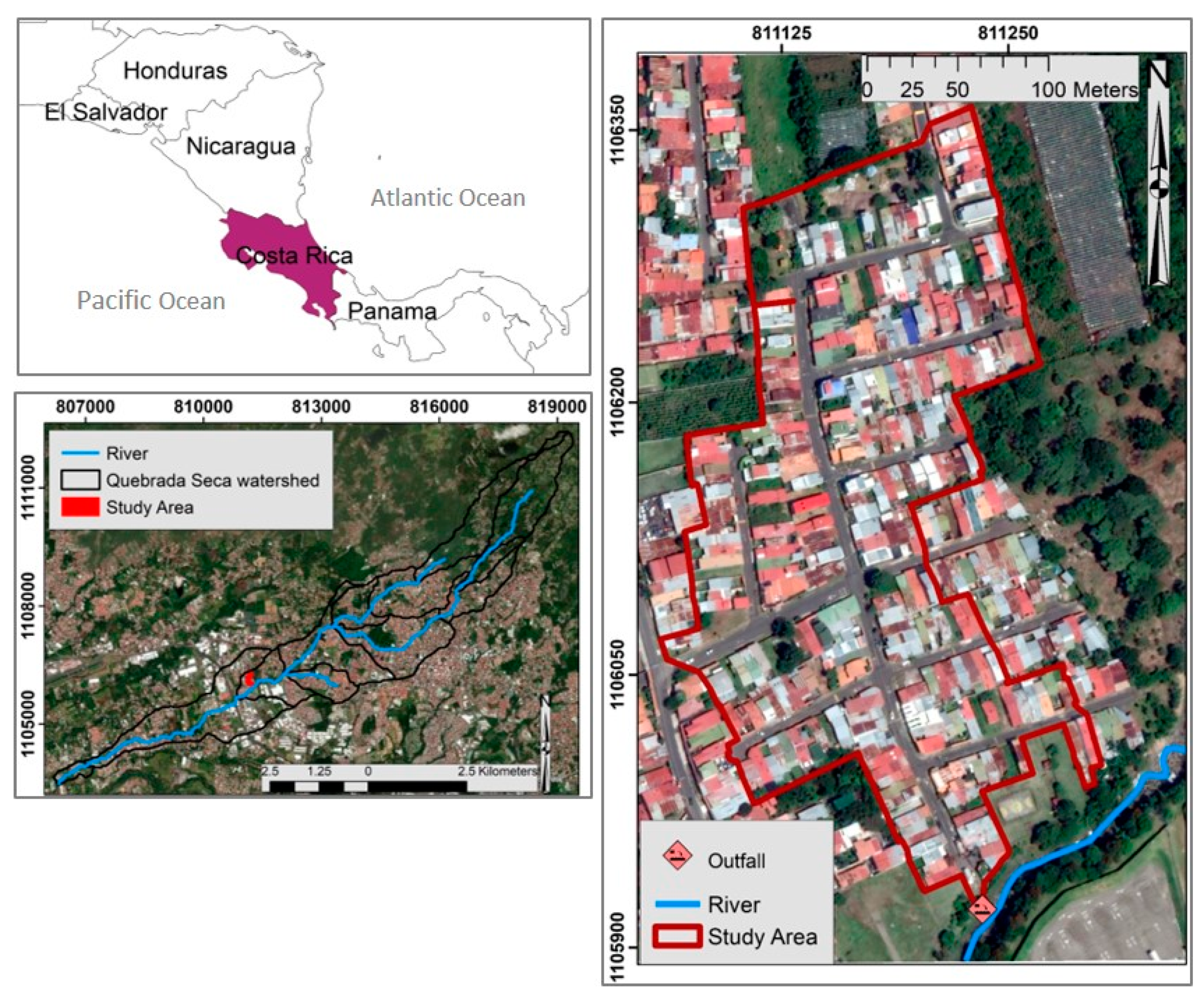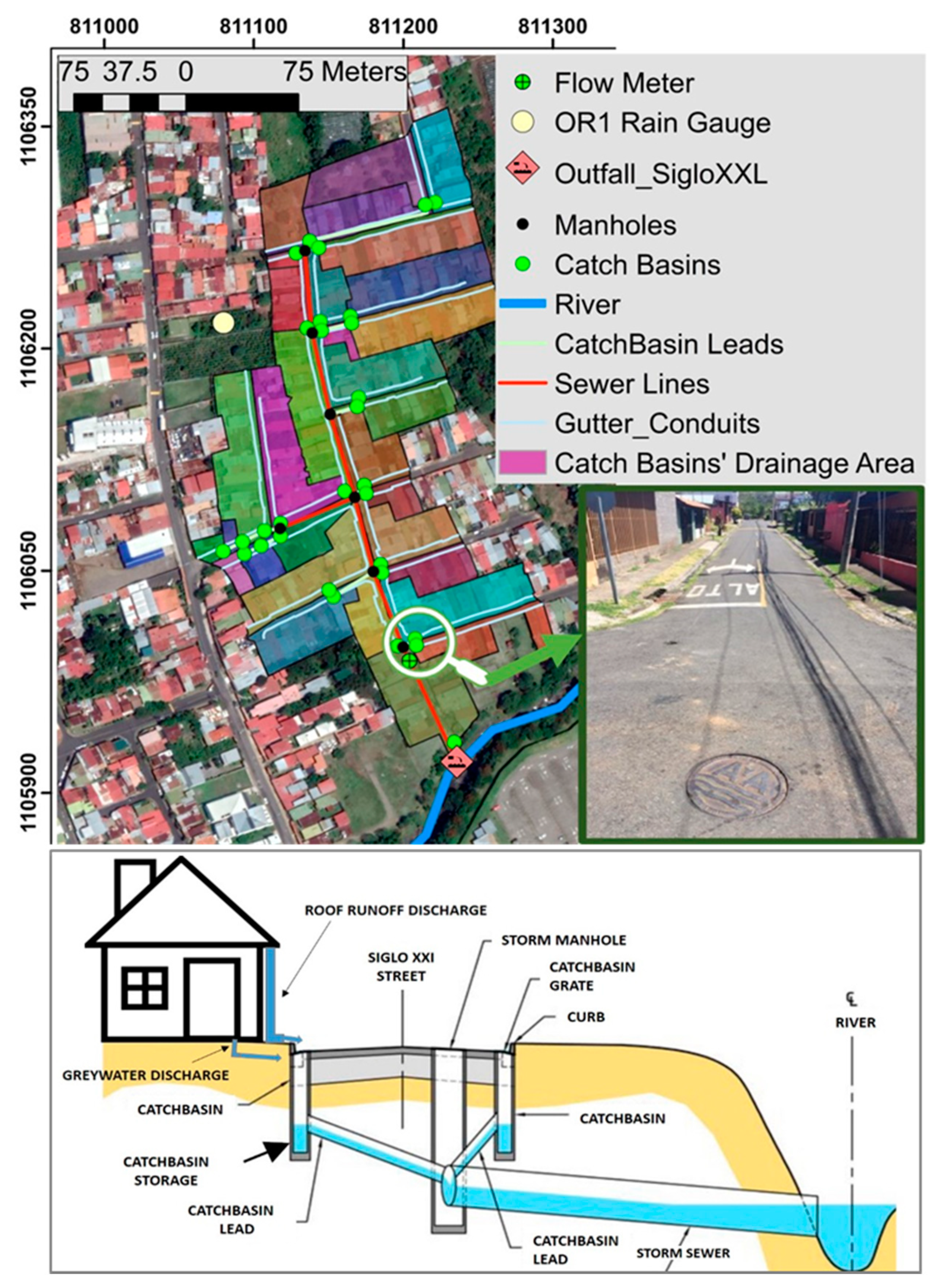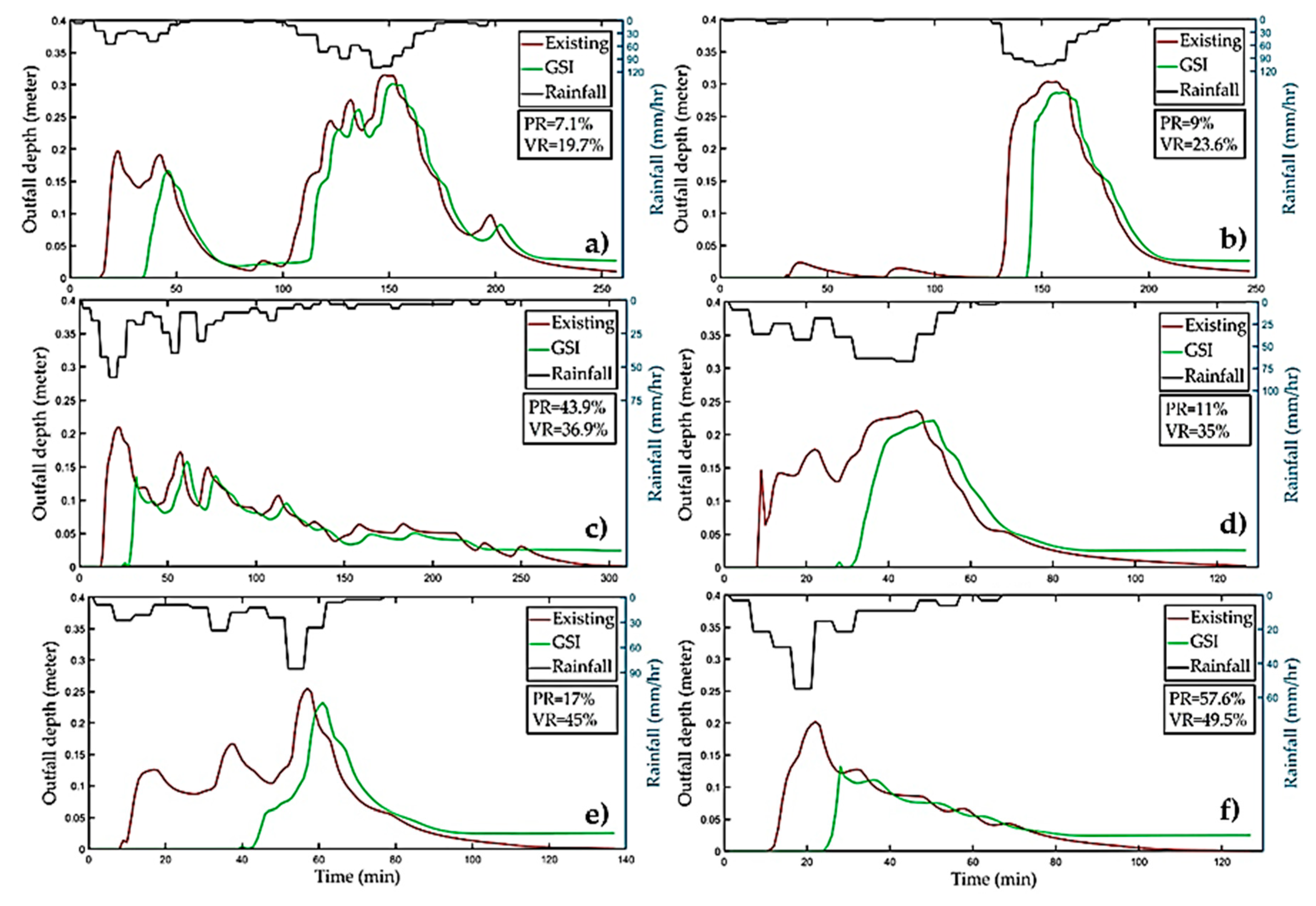Highly Resolved Rainfall-Runoff Simulation of Retrofitted Green Stormwater Infrastructure at the Micro-Watershed Scale
Abstract
:1. Introduction
2. Materials and Methods
2.1. Study Area
2.2. Data Collection for SWMM Model
2.2.1. Mapping of the Stormwater System
2.2.2. Generation of a High-Resolution Digital Elevation Model
2.2.3. Hydrological Measurements
2.3. Setting up the SWMM Model
2.3.1. Subcatchment Division and Parametrizations
2.3.2. Representation of Stormwater Structures in SWMM
2.3.3. Storm Event Selection
2.3.4. SWMM Model Calibration and Validation
- NSE = Nash–Sutcliffe coefficient (a measure of model efficiency);
- Yavg = mean of observed data for the constituent being evaluated;
- Yi = ith observation for the constituent being evaluated;
- n = number of hydrological parameter values;
- = ith simulated value for the constituent being evaluated.
2.3.5. Modeled GSI Measures
3. Results and Discussion
3.1. Data Gathering
3.2. Model Calibration and Validation Results
3.3. Current Rainfall-Runoff Response
3.4. Runoff Reduction Potential of GSI Elements
4. Conclusions
Author Contributions
Funding
Acknowledgments
Conflicts of Interest
References
- Brown, R.R.; Keath, N.; Wong, T.H.F. Urban water management in cities: Historical, current and future regimes. Water Sci. Technol. 2009, 59, 847–855. [Google Scholar] [CrossRef] [PubMed]
- Echols, S.; Pennypacker, E. The History of Stormwater Management and Background for Artful Rainwater Design. In Artful Rainwater Design; Island Press/Center for Resource Economics: Washington, DC, USA, 2015; pp. 7–22. [Google Scholar]
- Endreny, T.A. Land Use and Land Cover Effects on Runoff Processes: Urban and Suburban Development. In Encyclopedia of Hydrological Sciences; Major Reference Works; John Wiley & Sons, Ltd.: Chichester, UK, 2005; ISBN 9780470848944. [Google Scholar]
- Shuster, W.D.; Bonta, J.; Thurston, H.; Warnemuende, E.; Smith, D.R. Impacts of impervious surface on watershed hydrology: A review. Urban Water J. 2005, 2, 263–275. [Google Scholar] [CrossRef]
- Epps, T.H.; Hathaway, J.M. Establishing a Framework for the Spatial Identification of Effective Impervious Areas in Gauged Basins: Review and Case Study. J. Sustain. Water Built Environ. 2018, 4, 05018001. [Google Scholar] [CrossRef]
- Walsh, C.J.; Roy, A.H.; Feminella, J.W.; Cottingham, P.D.; Groffman, P.M.; Morgan, R.P. The urban stream syndrome: Current knowledge and the search for a cure. J. N. Am. Benthol. Soc. 2005, 24, 706–723. [Google Scholar] [CrossRef]
- Lee, J.G.; Heaney, J.P. Estimation of urban imperviousness and its impacts on storm water systems. J. Water Resour. Plan. Manag. 2003, 129, 419–426. [Google Scholar] [CrossRef]
- Dietz, M.E. Low Impact Development Practices: A Review of Current Research and Recommendations for Future Directions. Water. Air. Soil Pollut. 2007, 186, 351–363. [Google Scholar] [CrossRef]
- Chau, H. Green Infrastructure for Los Angeles: Addressing Urban Runoff and Water Supply Through Low Impact Development. 2009, pp. 1–136. Available online: https://www.adaptationclearinghouse.org/resources/green-infrastructure-for-los-angeles-addressing-urban-runoff-and-water-supply-through-low-impact-development.html (accessed on 19 September 2020).
- Deletic, A.; Fletcher, T.D. Performance of grass filters used for stormwater treatment—A field and modelling study. J. Hydrol. 2006, 317, 261–275. [Google Scholar] [CrossRef]
- Dietz, M.E.; Clausen, J.C. A field evaluation of rain garden flow and pollutant treatment. Water. Air. Soil Pollut. 2005, 167, 123–138. [Google Scholar] [CrossRef]
- Kasmin, H.; Stovin, V.; De Ville, S. An Evaluation of Green Roof Hydrological Performance in a Malaysian Context. In Proceedings of the 13th International Conference on Urban Drainage (ICUD 2014), Kuching, Malaysia, 7–12 September 2014. [Google Scholar]
- Niazi, M.; Nietch, C.; Maghrebi, M.; Asce, A.M.; Jackson, N.; Bennett, B.R.; Tryby, M.; Massoudieh, A.; Asce, M. Storm Water Management Model: Performance Review and Gap Analysis. J. Sustain. Water Built Environ. 2017, 3, 04017002. [Google Scholar] [CrossRef] [Green Version]
- Kaykhosravi, S.; Khan, U.; Jadidi, A. A Comprehensive Review of Low Impact Development Models for Research, Conceptual, Preliminary and Detailed Design Applications. Water 2018, 10, 1541. [Google Scholar] [CrossRef] [Green Version]
- Elliott, A.; Trowsdale, S. A review of models for low impact urban stormwater drainage. Environ. Model. Softw. 2007, 22, 394–405. [Google Scholar] [CrossRef]
- James, W.; Rossman, L.E.; James, W.R.C. User ’s Guide to SWMM5; US Environmental Protection Agency: Cincinnati, OH, USA, 1999; ISBN 9780980885330.
- Jayasooriya, V.M.; Ng, A.W.M. Tools for Modeling of Stormwater Management and Economics of Green Infrastructure Practices: A Review. Water Air Soil Pollut. 2014, 225, 2055. [Google Scholar] [CrossRef] [Green Version]
- Shrivastava, P. Urban water hydrological modelling. Int. J. Latest Trends Eng. Technol. 2016, 7, 489–493. [Google Scholar] [CrossRef]
- Krebs, G.; Kokkonen, T.; Setälä, H.; Koivusalo, H. Parameterization of a hydrological model for a large, ungauged urban catchment. Water 2016, 8, 443. [Google Scholar] [CrossRef]
- Lee, J.G.; Nietch, C.T.; Panguluri, S. Drainage area characterization for evaluating green infrastructure using the Storm Water Management Model. Hydrol. Earth Syst. Sci. 2018, 22, 2615–2635. [Google Scholar] [CrossRef] [Green Version]
- Sun, N.; Hall, M.; Hong, B.; Zhang, L. Impact of SWMM Catchment Discretization: Case Study in Syracuse, New York. J. Hydrol. Eng. 2014, 19, 223–234. [Google Scholar] [CrossRef]
- Chang, Q.; Kazama, S.; Touge, Y.; Aita, S. The effects of spatial discretization on performances and parameters of urban hydrological model. Water Sci. Technol. 2019, 80, 517–528. [Google Scholar] [CrossRef]
- Ghosh, I.; Hellweger, F.L. Effects of Spatial Resolution in Urban Hydrologic Simulations. J. Hydrol. Eng. 2012, 17, 129–137. [Google Scholar] [CrossRef] [Green Version]
- Park, S.Y.; Lee, K.W.; Park, I.H.; Ha, S.R. Effect of the aggregation level of surface runoff fields and sewer network for a SWMM simulation. Desalination 2008, 226, 328–337. [Google Scholar] [CrossRef]
- Krebs, G.; Kokkonen, T.; Valtanen, M.; Setälä, H.; Koivusalo, H. Spatial resolution considerations for urban hydrological modelling. J. Hydrol. 2014, 512, 482–497. [Google Scholar] [CrossRef]
- Houle, J. Performance analysis of two relatively small capacity urban retrofit stormwater controls. J. Water Manag. Modeling 2017, 6, 4013–4021. [Google Scholar] [CrossRef]
- Alves, A.; Sanchez, A.; Vojinovic, Z.; Seyoum, S.; Babel, M.; Brdjanovic, D. Evolutionary and holistic assessment of green-grey infrastructure for CSO reduction. Water (Switzerland) 2016, 8, 402. [Google Scholar] [CrossRef]
- Thiagarajan, M.; Newman, G.; Van Zandt, S. The projected impact of a neighborhood-scaled green-infrastructure retrofit. Sustainability 2018, 10, 3665. [Google Scholar] [CrossRef] [Green Version]
- Morsy, M.M.; Goodall, J.L.; Shatnawi, F.M.; Meadows, M.E. Distributed Stormwater Controls for Flood Mitigation within Urbanized Watersheds: Case Study of Rocky Branch Watershed in Columbia, South Carolina. J. Hydrol. Eng. 2016, 21, 05016025. [Google Scholar] [CrossRef]
- Avila, H.; Avila, L.; Sisa, A. Dispersed storage as stormwater runoff control in consolidated urban watersheds with flash flood risk. J. Water Resour. Plan. Manag. 2016, 142, 1–8. [Google Scholar] [CrossRef]
- de Mello Silva, C.; da Silva, G.B.L. Cumulative effect of the disconnection of impervious areas within residential lots on runoff generation and temporal patterns in a small urban area. J. Environ. Manag. 2020, 253, 109719. [Google Scholar] [CrossRef] [PubMed]
- Oreamuno Vega, R.; Villalobos Herrera, R. Estudios Hidrológicos e Hidráulicos en la Cuenca Quebrada Seca-Río Burío; Universidad de Costa Rica: San José, CA, USA, 2015. [Google Scholar]
- Singh, A.; Sarma, A.K.; Hack, J. Cost-Effective Optimization of Nature-Based Solutions for Reducing Urban Floods Considering Limited Space Availability. Environ. Process. 2020. [Google Scholar] [CrossRef]
- Fluhrer, T.; Hack, J. A methodology for assessing the implementation potential for retrofitted and multifunctional urban green infrastructure in public areas. Preprints 2020. [Google Scholar] [CrossRef]
- Neumann, V.A.; Hack, J. A Methodology of Policy Assessment at the Municipal Level: Costa Rica’s Readiness for the Implementation of Nature-Based-Solutions for Urban Stormwater Management. Sustainability 2019, 12, 230. [Google Scholar] [CrossRef] [Green Version]
- Senior, M.; Scheckenberger, R.; Bishop, B. Modeling catchbasins and inlets in SWMM. J. Water Manag. Model. 2018, 2018, 1–12. [Google Scholar] [CrossRef] [Green Version]
- Hoffmann, E.; Winde, F. Generating high-resolution digital elevation models for wetland research using Google EarthTM imagery—An example from South Africa. Water SA 2010, 36, 53–68. [Google Scholar]
- Hossain, F. Digital Elevation Modeling of Saint Martin Island, Bangladesh: A Method Based on Open Source Google Earth Data. Int. J. Adv. Res. 2018, 6, 379–389. [Google Scholar] [CrossRef] [Green Version]
- Day, T.J. On the precision of salt dilution gauging. J. Hydrol. 1976, 31, 293–306. [Google Scholar] [CrossRef]
- Rossman, L.A. Storm Water Management Model User Manual; Version 5; US Environmental Protection Agency: Washington, DC, USA, 2004.
- EPA Environmental Protection Agency; Rossman, L.A.; Huber, W.C. Storm Water Management Model Reference Manual. Volume I—Hydrology (Revised); US Environmental Protection Agency: Washington, DC, USA, 2016; Volume I, p. 231.
- Rossman, L.A. Storm Water Management Model Reference Manual Volume II—Hydraulics; US Environmental Protection Agency: Washington, DC, USA, 2017; Volume II, p. 190.
- Vega, R.O.; Herrera, R.V. Análisis Comparativo de dos Metodologías de Estimación de Caudales Extremos En Áreas Urbanas. In Congreso Corehisa 2016; San José, CA, USA, 2016; Available online: https://docplayer.es/88262112-Congreso-corehisa-2016-san-jose-costa-rica-del-08-y-09-de-setiembre-2016.html (accessed on 19 September 2020).
- US Environmental Protection Agency. Stormwater Management for Federal Facilities under Section 438 of the Energy Independence and Security Act; Cincinnati, OH, USA, 2009. Available online: https://www.epa.gov/nps/stormwater-management-federal-facilities-under-section-438-energy-independence-and-security-act (accessed on 19 September 2020).
- Nash, J.E.; Sutcliffe, J.V. River flow forecasting through conceptual models part I—A discussion of principles. J. Hydrol. 1970, 10, 282–290. [Google Scholar] [CrossRef]
- Moriasi, D.N.; Arnold, J.G.; Van Liew, M.W.; Bingner, R.L.; Harmel, R.D.; Veith, T.L. Model evaluation guidelines for systematic quantification of accuracy in watershed simulations. Trans. ASABE 2007, 50, 885–900. [Google Scholar] [CrossRef]
- James, W. Rules for Responsible Modeling; US Environmental Protection Agency: Cincinnati, OH, USA, 2005; ISBN 0-9683681-5-8.
- Choi, K.; Ball, J.E. Parameter estimation for urban runoff modelling. Urban Water 2002, 4, 31–41. [Google Scholar] [CrossRef]
- Gironás, J.; Niemann, J.D.; Roesner, L.A.; Rodriguez, F.; Andrieu, H. Evaluation of Methods for Representing Urban Terrain in Storm-Water Modeling. J. Hydrol. Eng. 2010, 15, 1–14. [Google Scholar] [CrossRef] [Green Version]
- Rossman, L.A.; Huber, W.C. Storm Water Management Model Reference Manual Volume III—Water Quality; US Environmental Protection Agency: Washington, DC, USA, 2016; Volume II, p. 161.
- Chigbu, N.; Okezie, M.; Arungwa, I.D. Comparative Analysis of Google Earth Derived Elevation with in-situ Total Station Method for Engineering Constructions. In FIG Working Week 2019—Geospatial Information for a Smarter Life and Environmental Resilience; FIG: Hanoi, Vietnam, 2019. [Google Scholar]
- Blumensaat, F.; Wolfram, M.; Krebs, P. Sewer model development under minimum data requirements. Environ. Earth Sci. 2012, 65, 1427–1437. [Google Scholar] [CrossRef]
- Chahinian, N.; Delenne, C.; Commandré, B.; Derras, M.; Deruelle, L.; Bailly, J.S. Automatic mapping of urban wastewater networks based on manhole cover locations. Comput. Environ. Urban Syst. 2019, 78. [Google Scholar] [CrossRef]
- Titterington, J.; Squibbs, G.; Digman, C.; Allitt, R.; Osborne, M.; Eccleston, P.; Wisdish, A. Code of Practice For The Hydraulic Modelling of Sewer Systems; The Chartered Institution of Water and Environmental Management (CIWEM): London, UK, 2017; Volume 1. [Google Scholar]





| Depression Storage, Ds (mm) | Manning’s Coefficient, n (s/m1/3) | Soil Conservation Service (SCS) Curve Number | ||||||||
|---|---|---|---|---|---|---|---|---|---|---|
| Permeable Area | Impermeable Area | Permeable Area | Impermeable Area | Conduit | Street/Roof | Garden | Park | |||
| 2.54 | Initial | Final | 0.3 | Initial | Final | Initial | Final | 98 | 34 | 58 |
| 6.35 | 3.35 | 0.01 | 0.03 | 0.16 | 0.01 | |||||
| Event Code | Date (Month/Day/Year) | Type of Event | Duration (h) | Mean Rainfall (mm/h) | Total Rainfall (mm) |
|---|---|---|---|---|---|
| S1 | 7/8/2019 | Used for Calibration | 6 | 4.5 | 27 |
| S2 | 7/14/2019 | Used for Validation | 5.37 | 4.547 | 24.4 |
| S3 | 4/24/2017 | Extreme Events | 4.25 | 22.5 | 95.5 |
| S4 | 8/29/2016 | 4.08 | 15.0 | 61.22 | |
| S5 | 5/24/2018 | 95 percentile | 5.08 | 8.2 | 41.91 |
| S6 | 11/11/2017 | 90 percentile | 2.08 | 16.7 | 34.8 |
| S7 | 11/9/2018 | 75 percentile | 2.25 | 11.7 | 26.42 |
| S8 | 5/31/2017 | 50 percentile | 1.1 | 13.6 | 15 |
| Layer | Parameters | Retention-Infiltration Basins (RIB) | Micro Infiltration Trenches (MT) | Street Planters (SP) |
|---|---|---|---|---|
| Surface | Berm Height (mm) | 250 | 100 | 200 |
| Vegetation Volume (fraction) | 0.1 | 0.0 | 0.1 | |
| Surface Roughness (Manning n) | 0.01 | 0.01 | 0.01 | |
| Storage | Thickness (mm) | 900 | 500 | 900 |
| Void Ratio (interspace/solid) | 0.75 | 0.75 | 0.75 | |
| Seepage Rate (mm/hour) | 80 | 0 | 80 | |
| Soil | Thickness (mm) | 350 | - | 400 |
| Porosity (Volume fraction) | 0.5 | - | 0.65 | |
| Field Capacity (Volume fraction) | 0.062 | - | 0.25 | |
| Wilting point (Volume fraction) | 0.024 | - | 0.15 | |
| Conductivity (mm/hour) | 140 | - | 140 | |
| Conductivity Slope (-) | 39.3 | - | 39.3 | |
| Suction head (mm) | 1.93 | - | 4.8 |
| Task | Event | Peak Depth | Mean Depth | R2 | NSE | ||||
|---|---|---|---|---|---|---|---|---|---|
| Observed (m) | Simulated (m) | RE (%) | Observed (m) | Simulated (m) | RE (%) | ||||
| Calibration | S1 | 0.168 | 0.1861 | −10 | 0.05033 | 0.0422 | 16 | 0.8 | 0.726 |
| Validation | S2 | 0.158 | 0.1376 | 12.9 | 0.0583 | 0.05219 | 10.4 | 0.8 | 0.768 |
© 2020 by the authors. Licensee MDPI, Basel, Switzerland. This article is an open access article distributed under the terms and conditions of the Creative Commons Attribution (CC BY) license (http://creativecommons.org/licenses/by/4.0/).
Share and Cite
Towsif Khan, S.; Chapa, F.; Hack, J. Highly Resolved Rainfall-Runoff Simulation of Retrofitted Green Stormwater Infrastructure at the Micro-Watershed Scale. Land 2020, 9, 339. https://doi.org/10.3390/land9090339
Towsif Khan S, Chapa F, Hack J. Highly Resolved Rainfall-Runoff Simulation of Retrofitted Green Stormwater Infrastructure at the Micro-Watershed Scale. Land. 2020; 9(9):339. https://doi.org/10.3390/land9090339
Chicago/Turabian StyleTowsif Khan, Sami, Fernando Chapa, and Jochen Hack. 2020. "Highly Resolved Rainfall-Runoff Simulation of Retrofitted Green Stormwater Infrastructure at the Micro-Watershed Scale" Land 9, no. 9: 339. https://doi.org/10.3390/land9090339
APA StyleTowsif Khan, S., Chapa, F., & Hack, J. (2020). Highly Resolved Rainfall-Runoff Simulation of Retrofitted Green Stormwater Infrastructure at the Micro-Watershed Scale. Land, 9(9), 339. https://doi.org/10.3390/land9090339






